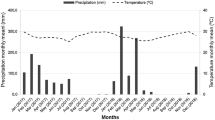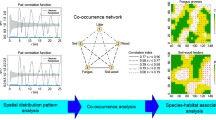Abstract
Soil-feeding termites are a critical trophic guild comprising more than a quarter of all termite species. Most soil-feeding termites build subterranean and diffuse gallery systems that are difficult to observe. In this study, we excavated the gallery systems of two soil-feeding termite species, Pericapritermes nitobei (Shiraki) and Sinocapritermes mushae (Oshima & Maki). Termite-harboring spaces were clusters of small cells connected with tunnels, with the cells usually adjacent to underground pieces of wood, stone, thick roots, and fibrous roots. Clusters of cells in a gallery system are referred to as nodes. In total, 90 nodes of five P. nitobei colonies and 64 nodes of seven S. mushae colonies were examined. The forager proportion of P. nitobei was the highest in nodes adjacent to fibrous roots, and that of S. mushae was the highest in nodes adjacent to pieces of wood, indicating that organic matter accumulated between the fibrous roots and underneath wood acted as a carbon source for the termites to feed upon. Nursed castes of P. nitobei, including larvae and eggs, were most frequently observed under thick roots and stones, but those of S. mushae were not located under any specific object. The nesting and feeding sites of P. nitobei were separate, but those of S. mushae overlapped. We speculate that the various food sources and their distributions are likely the main selection force for the gallery structures of soil-feeding termites.




Similar content being viewed by others
References
Abe T (1987) Evolution of life types in termites. In: Kawano S, Connell JH, Hidaka T (eds) Evolution and coadaptation in biotic communities. University of Tokyo Press, Tokyo, pp 125–148
Apolinário FE, Martius C (2004) Ecological role of termites (Insecta, Isoptera) in tree trunks in central Amazonian rain forests. For Ecol Manage 194:23–28
Bates D, Maechler M, Bolker B, Walker S (2014) lme4: Linear mixed-effects models using Eigen and S4. R package version 1.1-7. http://cran.r-project.org/package=lme4
Behr EA, Behr CT, Wilson LF (1972) Influence of wood hardness on feeding by the Eastern subterranean termite, Reticulitermes flavipes (Isoptera: Rhinotermitadae). Ann Entomol Soc Amer 65:457–460
Bonkowski M, Villenave C, Griffiths B (2009) Rhizosphere fauna: the functional and structural diversity of intimate interactions of soil fauna with plant roots. Plant Soil 321:213–233
Bourguignon T, Sobotnik J, Lepoint G, Martin JM, Roisin Y (2009) Niche differentiation among neotropical soldierless soil-feeding termites revealed by stable isotope ratios. Soil Biol Biochem 41:2038–2043
Bourguignon T, Sobotnik J, Lepoint G, Martin JM, Hardy OJ, Dejean A, Roisin Y (2011) Feeding ecology and phylogenetic structure of a complex neotropical termite assemblage, revealed by nitrogen stable isotope ratios. Ecol Entomol 36:261–269
Brauman A (2000) Effect of gut transit and mound deposit on soil organic matter transformations in the soil feeding termite: a review. Eur J Soil Biol 36:117–125
Brauman A, Bignell DE, Tayasu I (2000) Soil-feeding termites: biology, microbial associations and digestive mechanisms. In: Abe T, Bignell DE, Higashi M (eds) Termites: evolution, sociality, symbioses, ecology. Kluwer Academic Publishers, Dordrecht, pp 233–259
Chahartaghi M, Langel R, Scheu S, Ruess L (2005) Feeding guilds in Collembola based on nitrogen stable isotope ratios. Soil Biol Biochem 37:1718–1725
Chiu C-I (2014) Structures and functions of subterranean gallery systems of two soil-feeding termites. Dissertation, National Chung Hsing University, Taichung, Taiwan
Collins NM (1981) The role of termites in the decomposition of wood and leaf litter in the southern Guinea savanna of Nigeria. Oecologia 51:389–399
Crosland MWJ, Darlington JPEC (1997) The relationship between the primary and a subsidiary nest of Pericapritermes nitobei (Isoptera, Termitidae, Termitinae) in Hong Kong. Sociobiology 29:263–268
Curry JP, Schmidt O (2007) The feeding ecology of earthworms—a review. Pedobiologia 50:463–477
Donovan SE, Eggleton P, Bignell DE (2001) Gut content analysis and a new feeding group classification of termites. Ecol Entomol 26:356–366
Duncan FD, Hewitt PH (1989) Observations on the foraging behaviour of the harvester termite, Hodotermes mossambicus (Hagen) (Isoptera: Hodotermitidae). Bull Ent Res 79:631–642
Eggleton P, Bignell DE (1997) Secondary occupation of epigeal termite (Isoptera) mounds by other termites in the Mbalmayo Forest Reserve, southern Cameroon, and its biological significance. J Afr Zool 111:489–498
Eggleton P, Bignell DE, Sands WA, Mawdsley NA, Lawton JH, Wood TG, Bignell NC (1996) The diversity, abundance and biomass of termites under differing levels of disturbance in the Mbalmayo Forest Reserve, southern Cameroon. Phil Trans R Soc Lond B 351:51–68
Evans TA, Lai JCS, Toledano E, McDowall L, Rakotonarivo S, Lenz M (2005) Termites assess wood size by using vibration signals. P Natl Acad Sci USA 102:3732–3737
Garnier-Sillam E, Harry M (1995) Distribution of humic compounds in mounds of some soil-feeding termite species of tropical rainforests: its influence on soil structure stability. Insect Soc 42:167–185
Gay FJ, Calaby JH (1970) Termites of the Australian region. In: Krishna K, Weesner FM (eds) Biology of termites, vol 2. Academic Press, New York, pp 393–448
Goldsbrough CL, Hochuli DF, Shine R (2003) Invertebrate biodiversity under hot rocks: habitat use by the fauna of sandstone outcrops in the Sydney region. Biol Conserv 109:85–93
Haverty M, Nutting W (1975) A simulation of wood consumption by the subterranean termite Heterotermes aureus (Snyder), in an Arizona desert Grassland. Insect Soc 22:93–102
Hishi T, Hyodo F, Saitoh S, Takeda H (2007) The feeding habits of collembola along decomposition gradients using stable carbon and nitrogen isotope analyses. Soil Biol Biochem 39:1820–1823
Hsueh W-J (1998) Development of castes in Capritermes, Sinocapritermes, and Nasutitermes in Taiwan. Dissertation, National Taiwan University, Taipei, Taiwan
Inoue T, Takematsu Y, Hyodo F, Sugimoto A, Yamada A, Klangkaew C, Kirtibutr N, Abe T (2001) The abundance and biomass of subterranean termites (Isoptera) in a dry evergreen forest of northeast Thailand. Sociobiology 37:41–52
Inward DJG, Vogler AP, Eggleton P (2007) A comprehensive phylogenetic analysis of termites (Isoptera) illuminates key aspects of their evolutionary biology. Mol Phylogenet Evol 44:953–967
Jasmi AH, Ahmad AH (2011) Termite incidence on an Araucaria plantation forest in Teluk Bahang, Penang. Insects 2:469–474
Jones DT, Eggleton P (2011) Global biogeography of termites: a compilation of sources. In: Bignell DE, Roisin Y, Lo N (eds) Biology of termites: a modern synthesis. Springer, Heidelberg, pp 477–498
King EG, Spink WT (1969) Foraging galleries of the Formosan subterranean termite, Coptotermes formosanus, in Louisiana. Ann Entomol Soc Amer 62:536–542
Kirton LG, Cheng S (2007) Ring-barking and root debarking of dipterocarp saplings by termites in an enrichment planting site in Malaysia. J Trop For Sci 19:67–72
Kovoor J (1967) Etude radiographique du transit intestinal chez un Termite supérieur. Experientia 23:820–821
Krishna K (1961) A generic revision and phylogenetic study of the family Kalotermitidae (Isoptera). Bull Am Mus Nat Hist 122:303–408
Krishna K, Weesner FM (1970) The biology of termites. Academic Press, New York
Lavelle P, Spain AV (2001) Soil ecology. Kluwer Academics Publishers, Dordrecht
Legendre F, Whiting MF, Bordereau C, Cancello EM, Evans TA, Grandcolas P (2008) The phylogeny of termites (Dictyoptera: Isoptera) based on mitochondrial and nuclear markers: Implications for the evolution of the worker and pseudergate castes, and foraging behaviors. Mol Phylogenet Evol 48:615–627
Lenz M, Creffield JW, Evans TA, Kard B, Vongkaluang C, Sornnuwat Y, Lee CY, Yoshimura T, Tsunoda K (2012) Resistance of polyamide and polyethylene cable sheathings to termites in Australia, Thailand, USA, Malaysia and Japan: a comparison of four field assessment methods. Int Biodeter Biodegr 66:53–62
Maki M (1920) Termite and rice. Taiwan Noziho 14:36 (in Japanese)
Miura T, Matsumoto T (1998a) Foraging organization of the open-air processional lichenfeeding termite Hospitalitermes (Isoptera, Termitidae) in Borneo. Insect Soc 45:17–32
Miura T, Matsumoto T (1998b) Open-air litter foraging in the nasute termite Longipeditermes longipes (Isoptera: Termitidae). J Ins Beh 11:179–189
Nobel PS, Miller PM, Graham EA (1992) Influence of rocks on soil-temperature, soil-water potential, and rooting patterns for desert succulents. Oecologia 92:90–96
Noirot C (1970) The nests of termites. In: Krishna K, Weesner FM (eds) Biology of termites, vol 2. Academic Press, New York, pp 73–125
Noirot C, Darlington JPEC (2000) Termite nests: architecture, regulation and defence. In: Abe T, Bignell DE, Higashi M (eds) Termites: evolution, sociality, symbiosis, ecology. Kluwer Academic Publishers, Dordrecht, pp 121–139
Paterson E (2003) Importance of rhizodeposition in the coupling of plant and microbial productivity. Eur J Soil Sci 54:741–750
R Development Core Team (2013) R: a language and environment for statistical computing computer program, version 3.0.2. R Foundation for Statistical Computing, Vienna, Austria. http://www.R-project.org
Schneider K, Migge S, Norton RA, Scheu S, Langel R, Reineking A, Maraun M (2004) Trophic niche differentiation in soil microarthropods (Oribatida, Acari): evidence from stable isotope ratios (15 N/14 N). Soil Biol Biochem 36:1769–1774
Schuurman G (2005) Decomposition rates and termite assemblage composition in semiarid Africa. Ecology 86:1236–1249
Shellman-Reeve JS (1997) The spectrum of eusociality in termites. In: Choe JC, Crespi BJ (eds) The evolution of social behavior in insects and arachnids. Cambridge University Press, Cambridge, pp 52–93
Sleaford F, Bignell DE, Eggleton P (1996) A pilot analysis of gut contents in termites from the Mbalmayo Forest Reserve, Cameroon. Ecol Entomol 21:279–288
Smythe RV, Carter FL (1970a) Survival and behavior of three subterranean termite species in sawdust of eleven wood species. Ann Entomol Soc Amer 63:847–850
Smythe RV, Carter FL (1970b) Feeding responses to sound wood by Coptotermes formosanus, Reticulitermes flavipes and R. virginicus (Isoptera: Rhinotermitidae). Ann Entomol Soc Amer 63:841–847
Souza OFF, Brown VK (1994) Effects of habitat fragmentation on Amazonian termite communities. J Trop Ecol 10:197–206
Takamura K (2001) Effects of termite exclusion on decay of heavy and light hardwood in a tropical rain forest of Peninsular Malaysia. J Trop Ecol 17:541–548
Tayasu I, Abe T, Eggleton P, Bignell DE (1997) Nitrogen and carbon isotope ratios in termites: an indicator trophic habit along the gradient from wood-feeding to soil-feeding. Ecol Entomol 22:343–351
Tsai CC (2003) A taxonomic study of termite (Isoptera) from Taiwan. Dissertation, Tunghai University, Taichung, Taiwan
Tu TC (1954) Ecological supplement to a Formosan termite, Capritermes (Capreitermes) nitobei (Shiraki). J Formos Med Assoc 53:225–235 (in Chinese)
Acknowledgments
The authors are very grateful to Mei-Hwa Kuo and Ming-Chih Chiu (National Chung Hsing University) for their statistical analysis consultation. We thank Aaron Mullins (University of Florida) and the two anonymous reviewers for reviewing the manuscript and for their constructive comments. We also thank Taiwan Forestry Research Institute and the Forestry Bureau, Council of Agriculture, for issuing the collection permission. This study was partially supported by a Grant (MOST 102-2313-B-005-037-MY2) from the Taiwan Ministry of Science and Technology.
Author information
Authors and Affiliations
Corresponding author
Electronic supplementary material
Below is the link to the electronic supplementary material.
Rights and permissions
About this article
Cite this article
Chiu, CI., Yang, MM. & Li, HF. Structure and function of subterranean gallery systems of soil-feeding termites Pericapritermes nitobei and Sinocapritermes mushae . Insect. Soc. 62, 393–400 (2015). https://doi.org/10.1007/s00040-015-0416-4
Received:
Revised:
Accepted:
Published:
Issue Date:
DOI: https://doi.org/10.1007/s00040-015-0416-4




